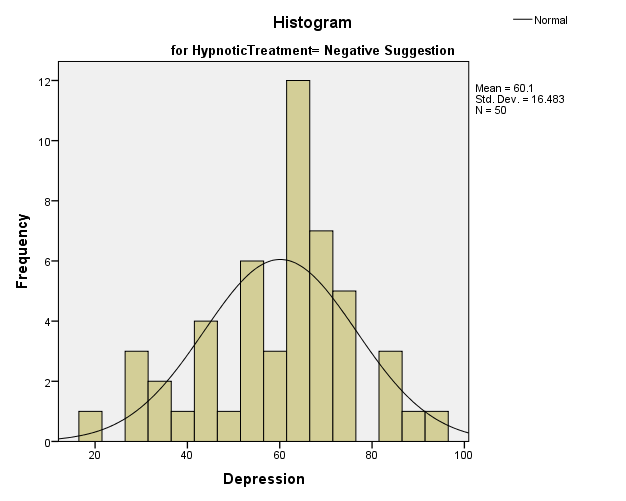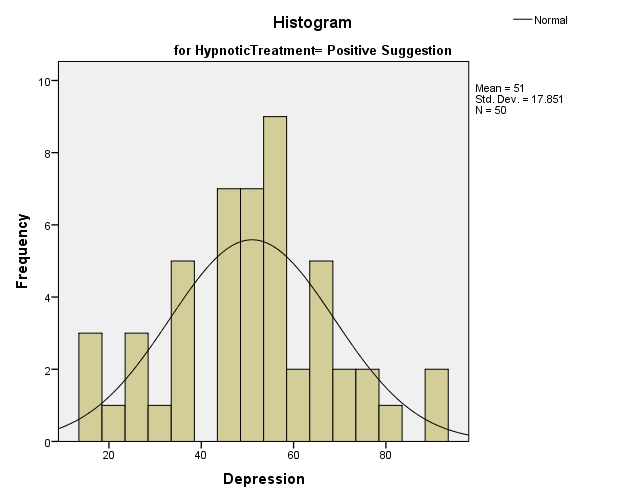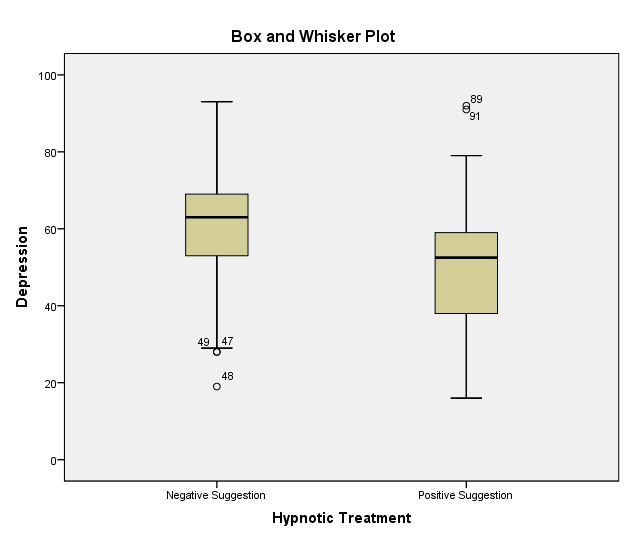Prepared Questionnaire
A questionnaire with 20 survey questions was designed to measure the degree of depression among patients with depression in two treatment groups with a view of establishing the influence of practitioners’ suggestions on the level of depression.
Kindly indicate the following demographic information
- Name
- Gender
- Age
Reading the following questions and provides appropriate answer, which effectively rate the present feelings using numbers 1-5 representing a rating scale of not at all, slightly, somewhat, moderately, and very much respectively.
Data Collection
To collect data, the study selected 100 patients with depression and randomly assigned them to two groups with different hypnotic treatments, namely, negative suggestions and positive suggestions. In the group that received negative suggestions, practitioners gave the patients negative prognosis of their depression while in the group that received positive suggestions, practitioners gave the patients positive prognosis.
The suggestions provided by practitioners acted as the manipulative influence on hypnotized patients with depression. The questionnaires were self-administered to 100 patients (56 males and 44 females) aged between 32 and 63 years with a mean age of 47.30. The findings were then coded into the statistical package for social sciences (SPSS version 20) for statistical analysis.
Results
Frequency Analysis
Frequency distribution was used in the exploratory data analysis to provide pattern and trends of depression relative to practitioners’ suggestions. Figure 1 and 2 below shows that distributions of the depression scores in both negative suggestion group and positive suggestion group follow the normal distribution. However, the distribution of depression scores in negative suggestion group depicts negative skewness while that of positive suggestion group depicts positive skewness.
Hence, the distributions of the depression scores in both groups are robust for independent-samples t-test. Figure 3 shows that the mean score of depression among patients in the negative suggestion group is higher than that of the ones in positive suggestion group. Moreover, the group that received negative suggestions has outliers of 48, 49, and 47 while the group that received positive suggestions has outliers of 91 and 89.



Descriptive Statistics
Descriptive statistics shows that there is an apparent difference in the mean scores of depression. According to the descriptive statistics in Table 1, patients with depression in the negative suggestion group have a higher level of depression (M = 60.10, SD = 16.783) than that of patients in the positive suggestion group (M = 51.00, SD = 17.851). Furthermore, depression scores of patients in the negative suggestion group have a range of 74 with maximum and minimum scores of 93 and 19 respectively. In contrast, depression scores of patients in the positive suggestion group have a range of 76 with maximum and minimum scores of 19 and 92 correspondingly.
Table 1.
Hypothesis Testing
The independent samples t-test (Table 2) shows that the difference between depression scores of negative suggestion group and negative suggestion group is statistically significant, t(98) = 2.648, p = 0.009.
Table 2.
Discussion of Results
The analysis of the data provided significant findings, which indicated how practitioners’ suggestions influence the manner in which patients rate their depression levels. Frequency distribution of the depression scores depicts that the two groups have different skewness. Comparatively, negative suggestion group has negative skewness while positive suggestion group has positive skewness. The distribution of data meets the assumption of normality, which is a requirement of hypothesis testing using independent samples t-test. Box and whisker plot shows that the mean of depression scores among patients in the negative suggestion group is higher than that of patients in the positive suggestion group.
The descriptive statistics reveal that suggestions of practitioners have marked influence on the assessment of depression scores. In essence, patients with depression who received negative suggestions had higher depression scores (M = 60.10, SD = 16.783) than patients with depression who received positive suggestions (M = 51.00, SD = 17.851). These findings mean that patients with depression under hypnosis are subject to the suggestions of practitioners. Moreover, these findings are consistent with the findings of Ludwig et al. (2014), which indicate that post-hypnotic suggestions influence decision-making and valuation. In this case, negative and positive suggestions in terms of prognosis by practitioners influenced self-evaluation and the rating of depression among patients with depression.
Hypothesis testing using the independent samples t-test shows that practitioners’ suggestions have statistically significant effect on self-evaluation of depression. Fundamentally, the hypothesis testing shows that the difference between depression scores of negative suggestion group (M = 60.10, SD = 16.783) and negative suggestion group (M = 51.00, SD = 17.851) is statistically significant, t(98) = 2.648, p = 0.009.
Untas et al. (2013) found out that hypnosis decreases depression, anxiety, sleepiness, and fatigue among patients under hemodialysis. These findings mean that hypnotherapy significantly reduces depression level among individuals. According to Cangas, Luciano, Perez-Alvarez, Ruiz-Sanchez, and Eisenbeck (2015), hypnotic suggestions influence the instructional behavior of hypnotized individuals and make them adopt rule-following behavior. From the findings, it is evident that patients with depression who received negative prognosis regarding suggestions reported higher levels of depression than patients with depression who received positive prognosis. Therefore, the findings of the study support the thesis that people under hypnosis are subject to instructions of practitioners.
References
Cangas, A., Luciano, C., Perez-Alvarez, M., Ruiz-Sanchez, L., & Eisenbeck, N. (2015). Disruption of hypnotic behavior. International Journal of Psychology and Psychological Therapy, 15(1), 3-15.
Ludwig, V., Stelzel, C., Krutiak, H., Magrabi, A., Steimke, R., Paschke, L.,…Walter, H. (2014). The suggestible brain: posthypnotic effects on value-based decision-making. Social Cognitive and Affective Neuroscience, 9(9), 1281-1288.
Untas, A., Chauveau, P., Dupré-Goudable, D., Kolko, A., Lakdja, F., & Cazenave, N. (2013). The effects of hypnosis on anxiety, depression, fatigue, and sleepiness in people undergoing hemodialysis: A clinical report. International Journal of Clinical and Experimental Hypnosis, 61(4), 475-483.